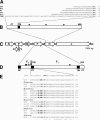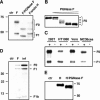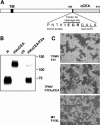Envelope targeting: hemagglutinin attachment specificity rather than fusion protein cleavage-activation restricts Tupaia paramyxovirus tropism
- PMID: 16051808
- PMCID: PMC1182650
- DOI: 10.1128/JVI.79.16.10155-10163.2005
Envelope targeting: hemagglutinin attachment specificity rather than fusion protein cleavage-activation restricts Tupaia paramyxovirus tropism
Abstract
To engineer a targeting envelope for gene and oncolytic vector delivery, we characterized and modified the envelope proteins of Tupaia paramyxovirus (TPMV), a relative of the morbilli- and henipaviruses that neither infects humans nor has cross-reactive relatives that infect humans. We completed the TPMV genomic sequence and noted that the predicted fusion (F) protein cleavage-activation site is not preceded by a canonical furin cleavage sequence. Coexpression of the TPMV F and hemagglutinin (H) proteins induced fusion of Tupaia baby fibroblasts but not of human cells, a finding consistent with the restricted TPMV host range. To identify the factors restricting fusion of non-Tupaia cells, we initially analyzed F protein cleavage. Even without an oligo- or monobasic protease cleavage sequence, TPMV F was cleaved in F1 and F2 subunits in human cells. Edman degradation of the F1 subunit yielded the sequence IFWGAIIA, placing the conserved phenylalanine in position 2, a novelty for paramyxoviruses but not the cause of fusion restriction. We then verified whether the lack of a TPMV H receptor limits fusion. Toward this end, we displayed a single-chain antibody (scFv) specific for the designated receptor human carcinoembryonic antigen on the TPMV H ectodomain. The H-scFv hybrid protein coexpressed with TPMV F mediated fusion of cells expressing the designated receptor, proving that the lack of a receptor limits fusion and that TPMV H can be retargeted. Targeting competence and the absence of antibodies in humans define the TPMV envelope as a module to be adapted for ferrying ribonucleocapsids of oncolytic viruses and gene delivery vectors.
Figures




References
-
- Asada, T. 1974. Treatment of human cancer with mumps virus. Cancer 34:1907-1928. - PubMed
-
- Bell, J. C., B. Lichty, and D. Stojdl. 2003. Getting oncolytic virus therapies off the ground. Cancer Cell 4:7-11. - PubMed
-
- Bendtsen, J. D., H. Nielsen, G. von Heijne, and S. Brunak. 2004. Improved prediction of signal peptides: SignalP 3.0. J. Mol. Biol. 340:783-795. - PubMed
-
- Bucheit, A. D., S. Kumar, D. M. Grote, Y. Lin, V. von Messling, R. B. Cattaneo, and A. K. Fielding. 2003. An oncolytic measles virus engineered to enter cells through the CD20 antigen. Mol. Ther. 7:62-72. - PubMed
Publication types
MeSH terms
Substances
Grants and funding
LinkOut - more resources
Full Text Sources
Other Literature Sources
Molecular Biology Databases
Miscellaneous

